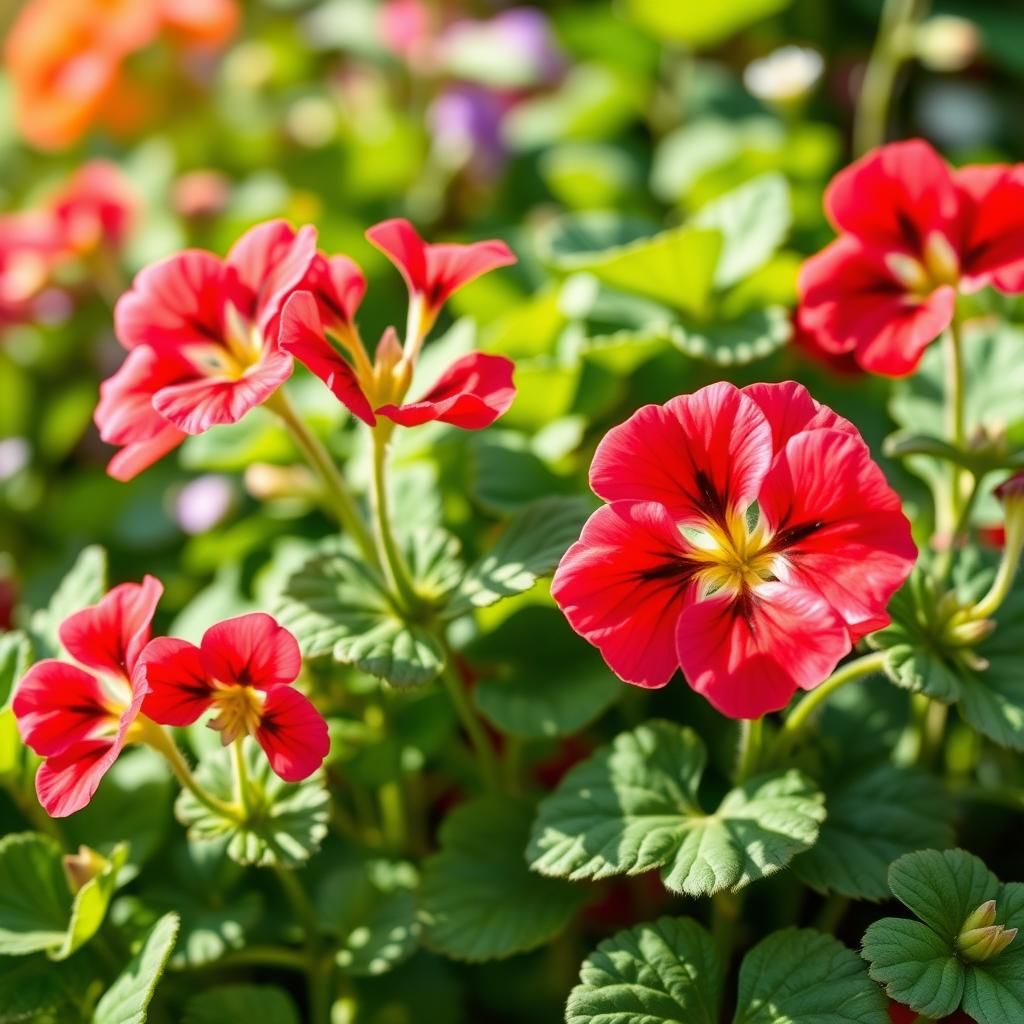Do Geraniums Do Well in Full Sun? Essential Tips for Thriving Plants

Geraniums are a popular choice for gardeners looking to add vibrant color to their outdoor spaces. With their lush foliage and stunning flowers, they can be a delightful addition to any garden. However, one common question arises: do geraniums thrive in full sun? Understanding their sunlight needs is crucial for ensuring these beautiful plants flourish. In this article, we will explore the ideal growing conditions for geraniums, provide essential tips for maximization of their health and beauty, and guide you on how to successfully incorporate these charming blooms into your sun-drenched garden.
Do Geraniums Thrive in Full Sun?
Geraniums are known for their vibrant blooms and are often a popular choice for gardeners. When it comes to their preference for sunlight, geraniums generally do well in full sun, which is defined as receiving six or more hours of direct sunlight each day. They thrive in bright conditions, as this encourages lush foliage and abundant flowering. However, while they can manage in full sun, it is essential to ensure that they are well-watered and have well-draining soil to prevent stress during the hottest parts of the day, particularly in regions with intense heat. Proper exposure will not only enhance their growth but also lead to healthier and more colorful plants.
Optimal Sunlight Conditions for Geraniums
Geraniums flourish when exposed to optimal sunlight conditions, ideally around 6-8 hours of full sun daily. In areas with extreme heat, providing some light afternoon shade can prevent leaf scorch and help the plants maintain their health and vigor. The intensity of sunlight can vary greatly depending on geographic location, so it's crucial to monitor your plants and adjust their lighting exposure accordingly.
Impact of Excessive Sunlight
While geraniums enjoy full sun, excessive sunlight can lead to certain issues such as leaf burn, where the edges of the leaves turn brown and crispy. This damage usually occurs during the hottest months, especially in desert-like environments. To mitigate this risk, consider situating geraniums where they receive morning sun, which is typically less intense, followed by some afternoon shade to protect them from the harshest rays.
Watering Needs Under Full Sun
Geraniums require regular watering, particularly when planted in full sun. When exposed to bright, direct sunlight, the soil can dry out more quickly, which may lead to stress in the plants. Therefore, it is vital to check the moisture level regularly and water them consistently. Ensure that the soil is well-draining to prevent waterlogging, which can lead to root rot.
Soil Requirements for Sun Exposure
The type of soil used for geraniums has a significant effect on their ability to thrive in full sun. Well-draining soil that retains some moisture is ideal, as it allows for proper root development while preventing excess water accumulation. Mixing in compost can enhance the soil's texture and nutrient content, leading to better growth and a more robust plant overall.
Seasonal Considerations for Geraniums
The season also plays a critical role in how well geraniums perform in full sun. During spring and summer, they actively grow and benefit from intense sunlight; however, in the fall and winter months, their growth slows down, and they may struggle to cope with the same level of exposure. Gardeners should adjust their care strategies according to the changing seasons, ensuring that geraniums receive adequate light while also protecting them from harsh winter conditions.
| Aspect | Recommendation |
|---|---|
| Sunlight | 6-8 hours of direct sunlight |
| Watering | Regularly check soil moisture |
| Soil type | Well-draining with moisture retention |
| Seasonal care | Adjust light exposure based on seasons |
| Afternoon shade | Consider during extreme heat |
How often do you water geraniums in full sun?


Geraniums are popular garden plants that thrive in sunny locations, but they do require careful attention when it comes to watering. In full sun conditions, it is generally recommended to water geraniums once a week. However, the specific frequency can vary based on factors such as temperature, soil type, and humidity levels. Geraniums prefer well-draining soil, and over-watering can lead to root rot while under-watering can cause wilting.
Factors Affecting Watering Frequency
Different environmental factors can influence how often you need to water geraniums in full sun.
- Temperature: During hot weather, geraniums may require more frequent watering.
- Soil Type: Sandy soils drain faster than clay soils, necessitating different watering schedules.
- Humidity Levels: Higher humidity can reduce the frequency of watering needs.
Signs of Under-Watering
Recognizing the signs of under-watering is crucial for the health of your geraniums.
- Wilting Leaves: Leaves may droop and become lifeless.
- Dry Soil: The top inch of soil feels dry to the touch.
- Yellowing Leaves: Leaf discoloration is a common symptom of stress.
Signs of Over-Watering
It is equally important to identify the signs of over-watering to prevent damage to geraniums.
- Mushy Roots: Roots may feel soft and disintegrate when touched.
- Yellowing Leaves: Initially, leaves may yellow before turning brown.
- Fungal Growth: Mold may appear on the soil surface or leaves.
Best Watering Practices
Implementing best practices in watering can lead to healthier geraniums.
- Water Early: Watering in the early morning helps reduce evaporation.
- Check Soil Moisture: Always check soil moisture before watering again.
- Use Room Temperature Water: Cold water can shock the plants.
Adjusting for Seasonal Changes
Adjust your watering routine according to seasonal changes for optimal results.
- Summer: Increase frequency during hot months to prevent dehydration.
- Fall: Gradually reduce watering as temperatures drop.
- Winter: Geraniums often need less water; monitor carefully to avoid over-watering.
Where is the best place to plant geraniums?
:strip_icc()/labeled-container-geraniums-evolvulus-0ce56395-c3b0f4c8814d4fae8c6ddfa7fa775823.jpg)
To find the best place to plant geraniums, it's essential to consider their particular needs regarding sunlight, soil type, and climate. Geraniums thrive in well-drained soil and require a substantial amount of sunlight to flourish. Ideally, they should be planted in locations that receive at least 6 hours of direct sunlight each day.
See also:
Optimal Sunlight Exposure
Geraniums are sun-loving plants, and their growth is heavily reliant on proper sunlight exposure. When choosing a location, it’s crucial to select a spot that receives ample sunlight.
- Direct Sunlight: Aim for a location that receives intense sunlight for at least 6-8 hours daily.
- Morning Sun: Morning sunlight is beneficial as it helps dry the leaves, reducing the risk of fungal diseases.
- Partial Shade: In extremely hot climates, partial shade during the hottest part of the day can protect the plants from scorching.
Soil Requirements
The type of soil you use can significantly affect the health and growth of your geraniums. They prefer well-draining soil that can retain moisture without becoming waterlogged.
- Drainage: Ensure the soil is well-drained to prevent root rot, which is common in overly moist conditions.
- Soil pH: A slightly acidic to neutral pH (around 6.0 to 7.0) is best for geraniums.
- Organic Matter: Incorporating organic matter like compost improves nutrient availability and soil texture.
Container vs. Ground Planting
Choosing between planting geraniums in containers or directly in the ground depends on a few factors, including space and aesthetics.
- Container Benefits: Containers allow for mobility, enabling changes in location for optimal light or aesthetics.
- Ground Planting: Ground planting provides a more stable environment and can lead to larger, healthier plants.
- Root Space: Containers can restrict root growth, so choose appropriately sized pots for optimal health.
Climate Considerations
The climate in your region plays a crucial role in determining the best place to plant geraniums. They thrive in temperate climates but can adapt to a range of conditions.
- Hardiness Zone: Check your local hardiness zone to ensure geraniums will survive the winter.
- Temperature: Ideal temperatures range from 60°F to 75°F; ensure they’re not exposed to extreme heat or frost.
- Humidity Levels: High humidity can lead to fungal issues, so ensure good air circulation around the plants.
Watering Needs
Watering plays an essential role in the health of geraniums, and choosing the right location can facilitate better watering practices.
- Water Drainage: Ensure the planting location allows excess water to drain away to prevent root rot.
- Watering Schedule: Water deeper but less frequently to encourage deep root growth.
- Signs of Overwatering: Watch for yellowing leaves as an indication of overwatering; adjust your location or schedule as needed.
Questions from Our Readers
Do geraniums do well in full sun?
Yes, geraniums thrive in full sun. They prefer at least six hours of direct sunlight per day, which helps them flourish with abundant blooms and healthy foliage. However, it's crucial to ensure they have enough water, as full sun exposure can dry out the soil more rapidly.
How much sunlight do geraniums need?
Geraniums typically need at least six hours of direct sunlight each day for optimal growth. While they can tolerate some shade, especially in the hottest parts of the day, full sun promotes the best blooming and overall health of the plants.
What type of soil is best for geraniums in full sun?
For geraniums planted in full sun, a well-draining soil mix is essential. A mix that includes organic matter and good drainage properties will help provide the necessary nutrients while preventing root rot caused by excess moisture retention.
See also:
Can geraniums survive in extremely hot conditions?
Yes, geraniums can survive in extremely hot conditions, but they require adequate water and care. During intense heat, it's important to monitor the soil moisture and provide mulching to help retain moisture and keep their roots cool.

If you want to read more articles like Do Geraniums Do Well in Full Sun? Essential Tips for Thriving Plants, we recommend you check out our Flowers category.
Leave a Reply
Related Articles